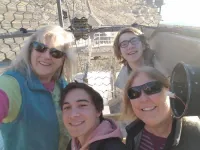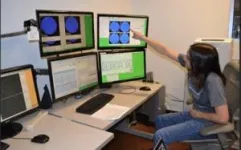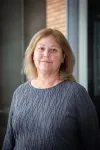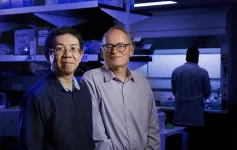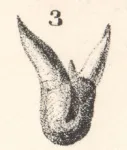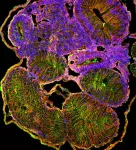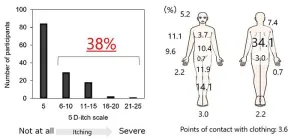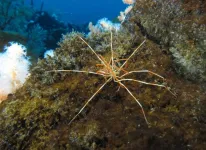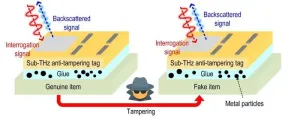(Press-News.org) February 16, 2024
Contact: Nick Wilson
805-235-8008; nwilso28@calpoly.edu
Second Year of Cal Poly Astronomy Fellowship to Examine High-Energy Particle Jets Near Supermassive Black Holes
SAN LUIS OBISPO — In the second year of the Astronomy Faculty Research Fellowship in Cal Poly’s Bailey College of Science and Mathematics, a research team will study extremely high-energy photons emitted by the extreme environment found near mega-sized black holes.
The fellowship was launched in 2023 through a generous donation from the Marrujo Foundation, established by Cal Poly alumnus Daniel Marrujo and his wife, Rosamaria, covering three years of the program.
The fellowship allows faculty to focus more closely with students on scientific research, offering them cutting-edge experiences as researchers.
Physics Professor Jodi Christiansen, the 2024 faculty fellow, is working with the VERITAS International Collaboration, part of the Center for Astrophysics, Harvard and Smithsonian, to study very-high-energy photons, or gamma rays, emitted by particles shooting down an astrophysical jet associated with supermassive black holes. Gamma rays are produced by the hottest and most energetic objects in the universe, such as neutron stars and pulsars, supernova explosions and regions around black holes.
Black holes, an area of such immense gravity that not even light can escape from it, sucks in just about anything in its proximity, but some of that matter can escape as high-speed jets of particles and radiation. The accretion disk, a massive field of gas, dust, asteroids and other matter swirling at massive speed around a black hole’s outer boundaries, wouldn't exist without black holes, typically formed by the death of a massive star. The disk produces X-rays and optical infrared and radio electromagnetic radiation that reveals the black hole’s location. Some of this material is vacuumed into the black hole, while other parts may be forced out as jets.
VERITAS, or Very Energetic Radiation Imaging Telescope Array System, gathers data from the night sky using a set of four, 12-meter telescopes in southern Arizona at the Fred Lawrence Whipple Observatory. The facility, owned and operated by the Smithsonian Astrophysical Observatory, enables research activities using gamma-ray and cosmic-ray astronomy.
The observatory is near Amado, Arizona, about 40 miles south of Tucson, on 8,553-foot Mount Hopkins. Christiansen's work has included trips to the site for research and viewing opportunities, as well as analyzing computer-based imaging remotely.
“These gamma rays are extremely energetic, so much so that they can't come from a hot star, which just isn’t energetic enough,” Christiansen said. “What we’re looking at comes from the environment near a supermassive black hole.”
The plasma particles that the Cal Poly team observes come from an environment that is so powerful that the “atoms have fallen apart,” Christiansen said.
Most galaxies have a supermassive black hole at their center, Christiansen said, and some release energy in the form of enormous blasts of particle streams.
“Our images have shown jets that are bigger than galaxies,” she said. “This jet structure is huge compared to the galaxy. There aren’t a lot of places in space that produce this level of energy."
Christiansen said that the high-energy gamma rays that reach Earth offer insights into the density and magnetic properties of the plasma very close to the supermassive black hole.
“There’s still a lot to learn about the physical mechanisms that produce the jets,” Christiansen said. “We don’t know why jets are formed. But we are very interested in how that energy can be released from this environment around the black hole.”
Her Cal Poly research teams, in recent years, have been active in discovering blazars, which are streams of high-energy electromagnetic radiation that are directed at an angle that points toward the earth.
A few years ago, Christiansen developed a software algorithm for a VERITAS telescope that improves the resolution of the device by about 25% — and also allows scientists to detect signals with 30% less observing time, enhancing the ability to discover rare blazars and other astronomical phenomena.
The first year of the Marrujo fellowship was led by Elizabeth Jeffery, a Cal Poly assistant professor of physics, who explored data related to locations and brightness of stars to better understand how long they’ve existed. Jeffrey’s work focused on white dwarf stars, which represent the endpoint of a low mass star’s life.
The Marrujo Foundation supports and works with educational institutions to further research in astronomy, astrophysics and cosmology to establish a world-leading fellowship ecosystem. The foundation’s efforts aim to ensure that institutional work challenges current understanding of space, creates new opportunities and makes a difference in people’s lives across the U.S. and around the globe.
“The inaugural year of this program has been an amazing journey marked by success, profound insights, and captivating discoveries," said Daniel Marrujo, who earned a master’s degree in materials engineering and a bachelor’s degree in electrical engineering with a minor in physics from Cal Poly. "Dedicated to offering cutting-edge research and educational training to Cal Poly students, our commitment resonates with the essence of advancing the Learn by Doing mission and nurturing the future cohort of extraordinary astronomers and scientists.”
“The Marrujo Foundation is filled with absolute delight as we witness the flourishing landscape of Cal Poly astronomy, and we eagerly anticipate the unfolding of remarkable accomplishments yet to come,” he added.
Marrujo is the former chief strategy officer and former director of the Office of Research and Technology Applications at the Defense Microelectronics Activity, delivering microelectronics solutions to the U.S. Department of Defense. He is the president and managing director at Sacramento-based Trusted Strategic Solutions, LLC, working with commercial, civil and national security entities to provide the foresight and expertise that ensures safety, time savings, and financial protections.
Photo 1: Mary Kertzman (DePauw University physics professor), Cal Poly students Connor Poggemann (physics) and Will Root (aerospace engineering) and Jodi Christiansen (Cal Poly physics professor) stand in front of one of the VERITAS telescopes.
Photo 2: Connor Poggemann (Cal Poly physics student) at the controls for the VERITAS telescopes.
Photo 3: Jodi Christiansen (Cal Poly physics professor)
About Bailey College of Science of Mathematics
Cal Poly’s Bailey College of Science and Mathematics, home to about 2,800 undergraduate and roughly 280 graduate students, offers degrees in biology, chemistry, kinesiology and public health, physics, mathematics, statistics, marine science, microbiology, and biochemistry. The college also houses the university’s undergraduate Liberal Studies program for future teachers, and Cal Poly’s post-baccalaureate School of Education. Bailey College embraces Cal Poly’s Learn by Doing mission, is an esteemed institution, noted for outstanding undergraduate research and significant student co-authorship participation on scientific journal publications.
END
Second year of Cal Poly astronomy fellowship to examine high-energy particle jets near supermassive black holes
Cal Poly working with the VERITAS International Collaboration to study gamma rays
2024-02-19
ELSE PRESS RELEASES FROM THIS DATE:
To boost a preschooler’s language skills, consider reminiscing
2024-02-19
Language skills are strong predictors of academic, socioemotional and behavioral outcomes when children enter school. They learn language in preschool years by interacting with others, especially their parents. Book sharing is a popular way parents engage young children in conversation. However, not all parents are comfortable with book sharing and not all children like having books read to them.
A new study on “parent talk” by Florida Atlantic University, in collaboration with Aarhus University in Denmark, provides ...
Husker team wins prize in contest to treat disease through gene editing
2024-02-19
Lincoln, Nebraska, Feb. 19, 2024 — A Husker research duo was named a first-round winner in a National Institutes of Health competition aimed at generating solutions for delivering genome-editing technology to the cells of people with rare and common diseases.
Janos Zempleni, Willa Cather Professor of molecular nutrition, and Jiantao Guo, professor of chemistry, were selected as Phase 1 winners in the NIH’s Targeted Genome Editor Delivery Challenge. The challenge is a three-phase competition with prizes totaling $6 million; the University of Nebraska–Lincoln team was among 30 initial recipients announced in December ...
Why two prehistoric sharks found in Ohio got new names
2024-02-19
COLUMBUS, Ohio – Until recently, Orthacanthus gracilis could have been considered the “John Smith” of prehistoric shark names, given how common it was.
Three different species of sharks from the late Paleozoic Era – about 310 million years ago – were mistakenly given that same name, causing lots of grief to paleontologists who studied and wrote about the sharks through the years and had trouble keeping them apart.
But now Loren Babcock, a professor of earth sciences at The Ohio State University, has finished the arduous task of renaming two of the three sharks – and in the process rediscovered a wealth ...
Study reveals five common ways in which the health of homeless pet owners and their companions is improved
2024-02-19
A rapid scoping review has been conducted which reveals five common ways in which the health of homeless pet owners and their companion animals is improved.
Ten percent of homeless people keep pets. But little information exists on specific intervention strategies for improving the health of homeless people and their pets who are often the only source of unconditional love or companionship in their life.
The study, published in the Human-Animal Interactions journal, found that the most common ways ...
Potassium depletion in soil threatens global crop yields
2024-02-19
Potassium deficiency in agricultural soils is a largely unrecognised but potentially significant threat to global food security if left unaddressed, finds new research involving researchers at UCL, University of Edinburgh and the UK Centre for Ecology & Hydrology.
The study, published in Nature Food, found that more potassium is being removed from agricultural soils than is being added, throughout many regions of the world. It also gives a series of recommendations for how to mitigate the issue.
Potassium is a vital nutrient for plant growth that ...
Poorly coiled frog guts help scientists unravel prevalent human birth anomaly
2024-02-19
How does our intestine, which can be at least 15 feet long, fit properly inside our bodies? As our digestive system grows, the gut tube goes through a series of dramatic looping and rotation to package the lengthening intestine. Failure of the gut to rotate properly during development results in a prevalent, but poorly understood, birth anomaly called intestinal malrotation. Now, in a study published in the journal Development, scientists from North Carolina State University have uncovered a potential cause of this life-threatening condition.
Intestinal malrotation affects 1 in 500 births but the underlying causes are not well understood. ...
Unveiling uremic toxins linked to itching in hemodialysis patients
2024-02-19
Niigata, Japan – Dr. Yamamoto et al. found the several uremic toxins as one of causes of itching in hemodialysis patients. Hemodialysis patients commonly experience itching on a daily basis, which is distributed throughout their bodies. They developed a "PBUT score" based on highly protein-bound uremic toxins (PBUT) that increase in the body with end-stage kidney disease. The PBUT score was associated with itching in hemodialysis patients.
I. Background of the Study
Patients with advanced chronic kidney disease (CKD) require kidney replacement therapy, such as hemodialysis, to manage their condition. Hemodialysis patients often experience various symptoms, ...
Communities must get prepared for increased flooding due to climate change, expert warns
2024-02-19
Communities must be better prepared for flooding in their homes and businesses, an expert warns, as climate change predictions suggest more extreme flooding globally.
Floods still inflict major costs to the economies, livelihoods and wellbeing of communities, with flood risks and impacts set to increase further due to climate change (IPCC, 2021).
Professor of Environmental Management, Lindsey McEwen explains how many experts now believe local communities have critical roles as key actors within flood risk management and disaster risk reduction.
Professor McEwen, author of Flood ...
Giant Antarctic sea spiders reproductive mystery solved by UH researchers
2024-02-18
Link to video and sound (details below): https://spaces.hightail.com/receive/JwM0o5gQdq
The reproduction of giant sea spiders in Antarctica has been largely unknown to researchers for more than 140 years, until now. University of Hawaiʻi at Mānoa scientists traveled to the remote continent and saw first-hand the behaviors of these mysterious creatures, and their findings could have wider implications for marine life and ocean ecosystems in Antarctica and around the world.
Sea spiders, or ...
This tiny, tamper-proof ID tag can authenticate almost anything
2024-02-18
A few years ago, MIT researchers invented a cryptographic ID tag that is several times smaller and significantly cheaper than the traditional radio frequency tags (RFIDs) that are often affixed to products to verify their authenticity.
This tiny tag, which offers improved security over RFIDs, utilizes terahertz waves, which are smaller and travel much faster than radio waves. But this terahertz tag shared a major security vulnerability with traditional RFIDs: A counterfeiter could peel the tag off a genuine item and reattach it to a fake, and the authentication system would be none the wiser.
The researchers have now surmounted ...
LAST 30 PRESS RELEASES:
Tracing the quick synthesis of an industrially important catalyst
New software sheds light on cancer’s hidden genetic networks
UT Health San Antonio awarded $3 million in CPRIT grants to bolster cancer research and prevention efforts in South Texas
Third symposium spotlights global challenge of new contaminants in China’s fight against pollution
From straw to soil harmony: International team reveals how biochar supercharges carbon-smart farming
Myeloma: How AI is redrawing the map of cancer care
Manhattan E. Charurat, Ph.D., MHS invested as the Homer and Martha Gudelsky Distinguished Professor in Medicine at the University of Maryland School of Medicine
Insilico Medicine’s Pharma.AI Q4 Winter Launch Recap: Revolutionizing drug discovery with cutting-edge AI innovations, accelerating the path to pharmaceutical superintelligence
Nanoplastics have diet-dependent impacts on digestive system health
Brain neuron death occurs throughout life and increases with age, a natural human protein drug may halt neuron death in Alzheimer’s disease
SPIE and CLP announce the recipients of the 2025 Advanced Photonics Young Innovator Award
Lessons from the Caldor Fire’s Christmas Valley ‘Miracle’
Ant societies rose by trading individual protection for collective power
Research reveals how ancient viral DNA shapes early embryonic development
A molecular gatekeeper that controls protein synthesis
New ‘cloaking device’ concept to shield sensitive tech from magnetic fields
Researchers show impact of mountain building and climate change on alpine biodiversity
Study models the transition from Neanderthals to modern humans in Europe
University of Phoenix College of Doctoral Studies releases white paper on AI-driven skilling to reduce burnout and restore worker autonomy
AIs fail at the game of visual “telephone”
The levers for a sustainable food system
Potential changes in US homelessness by ending federal support for housing first programs
Vulnerability of large language models to prompt injection when providing medical advice
Researchers develop new system for high-energy-density, long-life, multi-electron transfer bromine-based flow batteries
Ending federal support for housing first programs could increase U.S. homelessness by 5% in one year, new JAMA study finds
New research uncovers molecular ‘safety switch’ shielding cancers from immune attack
Bacteria resisting viral infection can still sink carbon to ocean floor
Younger biological age may increase depression risk in older women during COVID-19
Bharat Innovates 2026 National Basecamp Showcases India’s Most Promising Deep-Tech Ventures
Here’s what determines whether your income level rises or falls
[Press-News.org] Second year of Cal Poly astronomy fellowship to examine high-energy particle jets near supermassive black holesCal Poly working with the VERITAS International Collaboration to study gamma rays
